
I. SPANISH DISCONTINUOUS SONG CANARY
It could be thought that this is an indefinitely song canary by the variety and diversity of this type of singing canary and therefore, unworthy of being considered as a genuine race of singing, but nothing further from reality.
The song homogeneity of the specimens of this race is based on the specialization of the non-continuous turns of pace, mainly on the discontinuous rhythm ( four or fewer syllables issued in a second), records issued in half pitch high and moderately high and predominantly bright voice. This quality must accompany twists and customize the rest of timbral colours issued by the specimen. In addition to above, among the main features of the discontinuous canary, is the development of a slow issue of discontinuous rhythm turns due to their method of selection (innateness of song development and lack of education with adult canaries or any other artificial method).
Special emphasis has been placed on the melodion development of so-called compound turns, in horizontally conjunction (side by side in the same attack or sound) and vertically (perceived by the listener, real or as a result of acoustic phenomena, two or more sounds made at the same time or in overlay or side; result of the possible involvement in the issue from both sides of the syrinx-bilateral pattern of phonation, compared predominance laterality of sound production in only one side of the prevailing syrinx in other specimens-or performance of the complex system of filters present in the sound motor functions of the song canary)
Finally, this race is also distinguished because of the turns or variations that make up its song not respond to a predetermined phonetic, structure( limited phonetic text) as it happens with the melodion repertoire of other races, that therefore we consider they have a highly stereotyped song.
PHENOTYPE
The Spanish discontinuous song canary doesn´t have a fixed colour or shape standard, so the breeder is free to adjust their phenotypic characteristics according to the common development of the wild canary. Red factor or the presence of ripples in the plumage will not be accepted.
II EVALUTION FORM
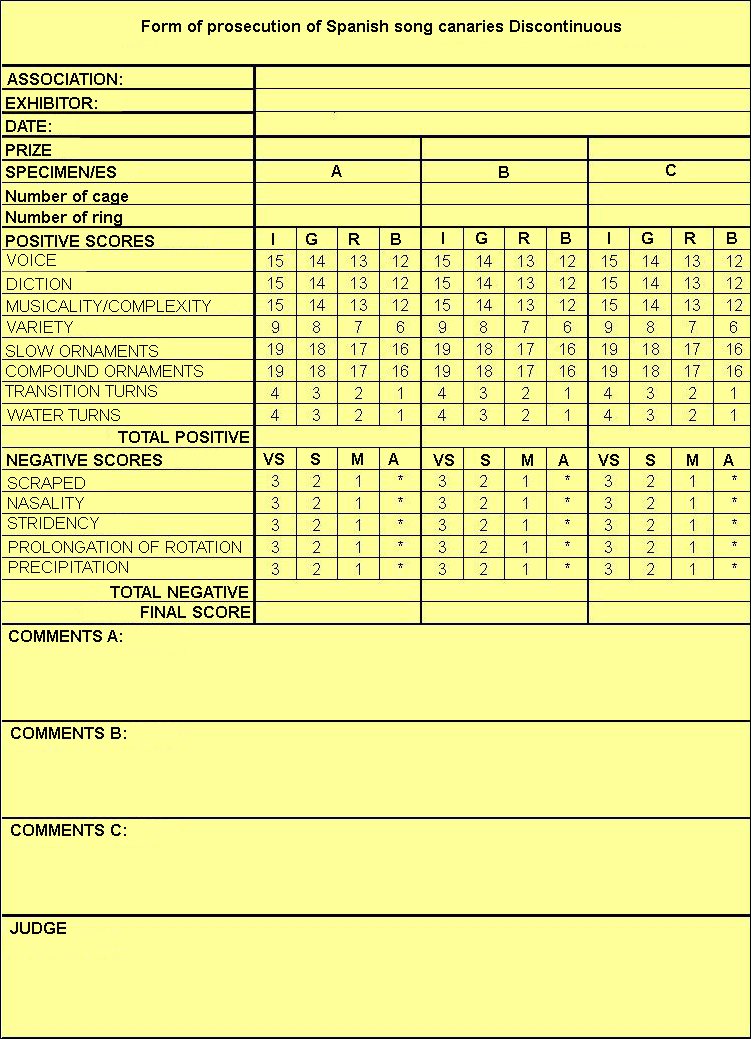
1. POSITIVE SCORES
1.1. Voice.
The Spanish song canary singing batch must issue a medium-high tonal register and/or moderately high(high). The normal recorded frecuency of its spectrogram has a range between 1 and 7 kHz, records low or medium-low only permissible in specific and concrete sounds. It´s voice should be bright and sound.
1.2. Dictión.
It must issue or "utter" sound in a correct way. By analogy with human language we say that the sounds issued by canaries are composed of consonants and vowels, although due to the complexity of many of the sounds they do, they can not successfully transcribe onomatopedically with our limited phonetic system. Diction of our canaries should be clean and crisp, with a good balance between consonants and vowels phonemes, but with a predominance of vowels.
1.3. Musicality/Complexity.
Understand the issue as musical, rhythmic and melodic singing, evidenced by the ability of the sample to play with the issue rate, tones and intensity of sounds.
Understand the capacity and complexity of the sample to vary the structure of the song, changing the order of issuance of drafts or omitting or inserting sounds on the fly, as well as the ability to make the same sound changes.
1.4. Variety.
Although the present code puts the quality of the sounds issued by the canary before the quantity, it will be rewarded the wealthy and variety of the number of turns which take part in the song as well as its capacity to issue several different songs in its singing.
1.5. Slow Ornaments.
Turns formed by simple of polysyllabic sounds of discontinuous rhythm and no watery tones, in which the specimen drags out the vowels or slows down. In a clearly beaten way the issue of rhythmic turn in connection with the medium pare of issue of the rest of variations that take part in the song.
Onomatopoeic example:
tuiiio tuiiio tuiiio, doooili doooili...,
tuuuilo tuuuilo tuuuilo, tuiii tuiii...
taa taa taa,
tiroliiio tiroliiio tiroliiio,
flioriiio flioriiio flioriiio
Graphic example:
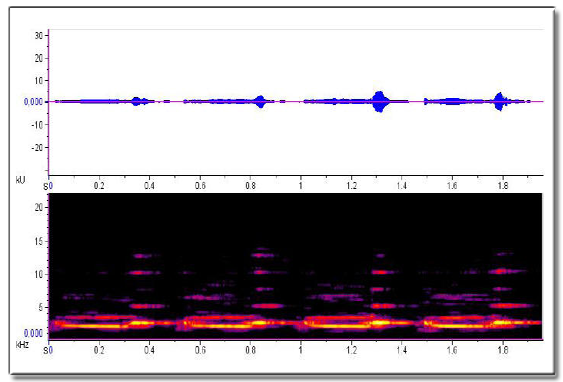
1.6. Compound Ornaments.
Polysyllabic turns in which take part /K/ phoneme and/or a watery sound. They will be also considered as compound ornaments those sounds in which it produces in the listener the acoustic feeling of being hearing more than one sound at the same time.
Onomatopoeic example:
cloblob cloblob cloblob
tigluy tigluy tigluy
piroglok piroglok piroglok
toclok toclok toclok
Graphic example:
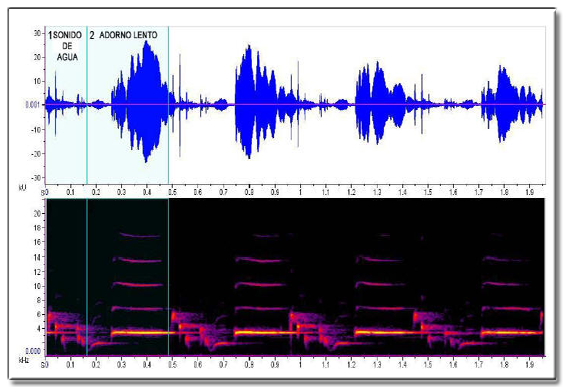
1.7. Transition Turns.
Turns composed by simple and polysyllabic sounds, of usually semi constant rhythm and no watery voice, which are used as link or rest and enrich the song contributing musically with variety and contrast.
Onomatopoeic example:
tilotilotilo
pillopillopillo
linlinlinlin
tuituituitui
plipliplipli
lulululululu
cloclocloclo
tiotiotiotiotio
Graphic example:
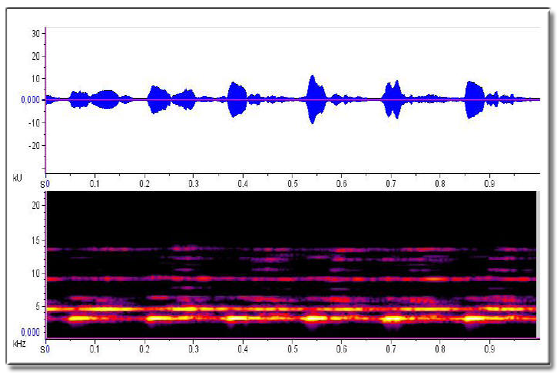
1.8. Water Turns.
Simple turns, composed by monosyllabic or polysyllabic sounds in which only consonants take part in one of the syllables (simple polysyllabic), of watery voice, and discontinuous or semicontinuous rhythm issue.
Onomatopoeic example:
bloblobloblo
gloglogloglo
glokglokglokglok
blob blob blob,
blou blou blou,
bloui bloui bloui
Graphic example:
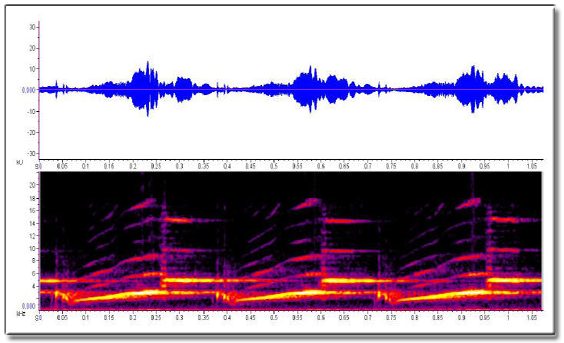
2. NEGATIVE SCORES
2.1. Scrapeds.
Fault consisting of giving out sounds with an excessive predominance of /r/ phoneme over the vowel, leading to an extremely unpleasant sound for our ear.
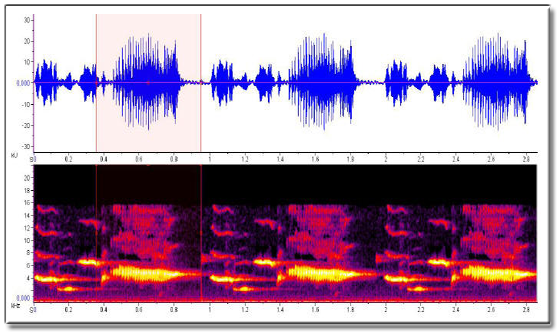
2.2. Stridencies.
Stridencies are faults that consist on a sharp and sudden raising of the sound of a turn in tone or intensity, producing a high flown sound that breaks the melodic line of the song.
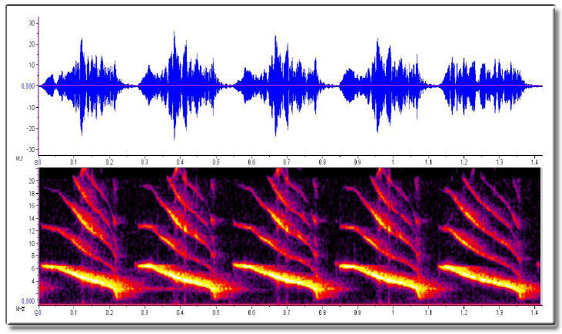
2.3. Nasality.
Nasality is a fault consisting of producing imperfect sounds similar to those a person gives out with problems in his respiratory tract when speaking, hence the name of nasality. It ´s usually due to the inadequate diction of the vowels which take part in the turn or when there are certain consonants involved ( as for example /n/ and /G/ that, due to its voice, show a higher tendency to show signs of this fault, it can be also due to respiratory system problems of the specimen.
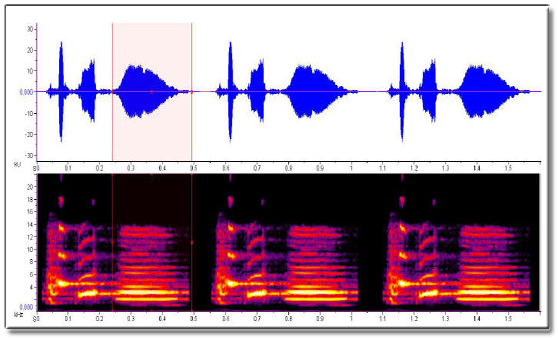
2.4. Prolongation of rotation.
Fault consisting of an excessive turn length that breaks the melodic line of the song. It won’t be considered turn lengthening when the canary modulates its tone or intensity or plays with its issue rhythm, provided doesn’t break the song melodic line.
2.5. Precipitation.
Fault consisting on a rush and hasty song issue.
II SONG ASSESSMENT
1. Song assessment previous questions.
Before assessing the song, it will must be expected the specimen starts to sing reaching the adequate intonation and defining several turns or variations that make up it. We will must also to ensure the specimen enjoys perfect health and, concretely isn’t suffering from any kind of illness what can affect the voice or respiratory tract.
In the event of the specimen doesn’t reach the song development in an adequate way during the time of its trial because it gives out the sound in a choking way and lack of any link, it will be recorded this factor in the trial file.
If the specimen shows loss of voice symptom or it is hoarse its song won’t be valued either, starting the cause in the trial file. They won’t be valued either the specimens that show, when they are singing, the consequences of an excessive jealousy state, being evident by the song issue in the stand over position( specimen length way placed and with the wings down, jumping nervous from a stick to other in the cage singing with higher intensity or volume and rhythm than normal)
2. Qualities of the canary like performer assessment.
2.1. Voice.
Well defined the Spanish Canary Cong Discontinuous voice as brilliant and bearing in mind that the song must be given out predominantly in a medium or moderately high tone file, while that in the song of every canary we find out three king of passages concerning to bell and tone mainly (metal, empty and watery) we will apply the punctuations in the following way:
Ideal, 15 points: When brilliance is joined to the metal tone of the song.
Good, 14 points: When together with the brilliance there is a balance a among metallic empty and watery sounds.
Regular, 13 points: When without lossing the brilliance predominate empty and/or watery sounds in the song.
Bad, 12 points: Shorten, broken, nasal or too poor voices, when its seriousness doesn’t prevent the specimen assessment.
2.2. Diction.
Ideal, 15 points: When consonants are clearly perceived but predominate the vowels sound, making the sound works softer and nicer.
Good, 14 points: When there is a balance in the consonant and vowels pronunciation.
Regular, 13 points: When the consonants sound predominate over vowels one.
Bad, 12 points: When it is hard to distinguish consonants from sounds.
2.3. Musicality/Complexity.
Ideal, 15 points: When musicality and complexity come together whit the song.
Good, 14 points: When musicality predominates in the song.
Regular, 13 points: When complexity predominates in the song.
Bad, 12 points: Pour musicality and complexity in the song.
3. SONG ASSESSMENT.
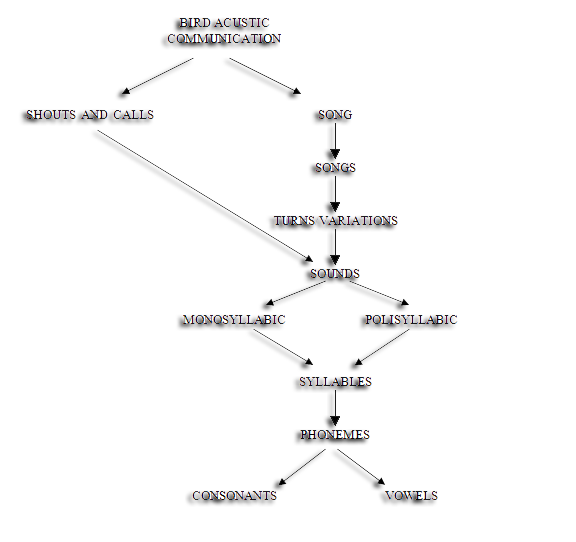
3.1. Variety.
Ideal, 9 points: Turns and songs variety.
Good, 8 points: Songs variety.
Regular, 7 points: Turns variety.
Bad, 6 points: Poor or repetitive turns repertoire.
3.2. Turns assessment.
To start the analysis and assessment of the different turns that the canary voices in its song, we must answer three questions:
WHAT KING OF TURN DOES THE CANARY VOICE?
HOW DOES THE CANARY VOICE IT?
WHERE DOES THE CANARY VOICE IT?
1º TURN IDENTIFICATION: Answer first question.
a) phonetic text analysis(simple, polysyllabic or compound)
1) Simple turn: Those made up by monosyllabic or polysyllabic sounds in which take part only consonants in one of the syllables, these last sounds will be named simple polysyllabic.
2) Polysyllabic turn: Those made up by polysyllabic sounds in which take part consonants in more than one syllable.
3) Compound turns: Turns made up by more than one tone colour sound (watery-metallic, empty-metallic, empty-watery, watery-metallic, so on).
b) Issue rhythm study (continuous, semicontinuous and discontinuous), because there are turns that share the same consonants and vowels and it is only distinguishable attending to the issue rhythm. They will be considered in this respect:
1) continuous rhythm turns: Those with issue rhythm between 10 to 15 (depending on the higher or lower tone of the sound) or more syllable in a second, cause by what it seems that the sound is happening without continuity solution; because our ears aren’t able to perceive the several syllables that the canary is able to produce due to the so-called sensory persistence phenomenon (our brain believes that is listening a continuons sound)
2) Semicontinuons rhythm turns: our ear is able to distinguish each one of the syllables that make up the turn, because the issue rhythm is between 5 a 9 syllables by second, although the semicontinuous rhythm turns that can be better valued, because its issue way are those given up with a rhythm between 5 to 7 syllables in a second.
3) Discontinuous rhythm turns: The division between the different syllables or words of the turn are even more marked (we so-called words to the different sounds that make up o turn or variation and are composed by two or more syllables interweaved), the issue rhythm is four or less syllables in a second.
This classification must not be considered in a rigid way, because the same king of turns con be given out with different rhythms.
2º TURN ANALYSIS: Answer 2nd and 3rd questions.
a) DICTION PURITY
Poor: It is hard to distinguish the consonants that take part in the turn.
Regular: The consonants sound predominates over the vowels. Good: Balance between consonants and vowels pronunciation.
Very good: The consonants are clearly perceived but the vowels sound predominates, making softer and pleasant the final sound.
b) CONTROL AND DIFFICULTY (issue way)
- Concerning to tone: Straight or modulated (upward, downward or wavy). They are considerated more valuated the modulated the modulated turns, being its worth order from higher to lower value the following: a) Wavied modulation b) downward modulation; and c) up ward modulation.
Concerning to intensity (musical nuances involving the capacity of the specimen in playing with the turn sound intensity; example: get louder, get downer, forte, fortissimo, piano, pianissimo, so on).
Concerning to rhythm: capacity of the specimen to alter the turn musical rhythm (i.e.: raising or falling the issue rhythm).
Phonetics complexity of the turn (paying attention to the number of consonants and vowels taking part in the turn)
Turn length: It can’t be either very short or very lengthy, keeping proportion and balance with the turn which composed the song.
c) BEAUTY: INTRINSIC MUSICALITY (turn itself) and EXTRINSIC (the turn in the canary’s song or melody).
3º SCORE APPLICATION.
1º) When there are several turns in the same epigraph of the trial list, the assessment will be made as the coldest and the most objective as possible, paying attention to their medium quality. We have to avoid being king by the happening of extremely valued turns together with other mediocre or faulty ones or, contrary, too strict to consider the faults over the virtues.
2º) The score scale of the different turns is divided in four ladders:
a) Ideal: foor very good, excellent or superior turns.
b) Good: Turns considered like this.
c) Regular: For regular, enough or passable turns.
d) Bad: For poor but not faulty quality turns.
3º) Diction purity, the control and difficulty, while the beauty and musicality of the turn will bring about the score step.
Schematically, the score application will be the following:
POSITIVE SCORES |
I | G | R | B |
SLOW ORNAMENTS |
19 | 18 | 16 | 15 |
COMPOUND ORNAMENT |
19 | 18 | 16 | 15 |
TRANSACTION TURNS |
19 | 18 | 16 | 15 |
TURNS WATER |
19 | 18 | 16 | 15 |
3.3 Negative score application
The penalty will be made by paying attention to the fault and the way it affects the rest of the canary song.
NEGATIVE SCORES |
Very serius | Serius | Light | Absence |
SCRAPED |
3 | 2 | 1 | * |
NASALITY |
3 | 2 | 1 | * |
STRIDENCY |
3 | 2 | 1 | * |
TURN LENGTH |
3 | 2 | 1 | * |
PRECIPITATION |
3 | 2 | 1 | * |
4. DISCUALIFICATION REASONS
4.1 Administrative disqualification reasons
a) Specimen without ring set.
b) Ring with no diameter set that can be removed from the leg of the bird without damaging it.
c) Show signs that can identify the breeder.
d) The bird has got more than one ring.
4.2 Disqualification reasons coming from the Song Code
1) Issue in the song of continuous rhythm sounds.
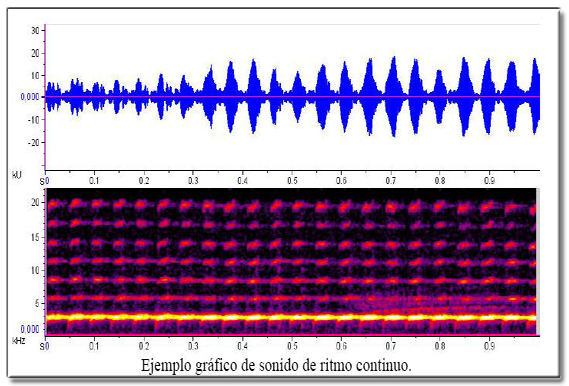
2) Any character in the phenotype of the specimen that bearing the judge to the belief that it is product of the cross, education or selective diversion with other race or variety:
a) Observe ruffled feathers in the phenotype that highlight a possible cross with curled position canaries.
b) Observe red factor.
c) Presence, in the issue form or composition, of own characteristic of song canary other races.
3) Those other being accepted by general meeting of the technical committee.
5. TIEBREAKER RULES
1º) Concerning to negative sore absence.
2º) Concerning to the less quantity of negative score.
3º) Concerning to the less amount of warnings in negative scores.
4º) Concerning to the quantity of voice, diction and musicality or complexity ratings.
5º) Concerning to slow ornaments score.
6º) Concerning to compound ornaments score.
7º) Concerning to variety score.
8º) If the tie persists, the judge decides.
III GENERAL RULES TO THE JUDGEMENTS
1. Before the judgement
Before starting the judgement, there is a serie of nuances that are advisable to take into account because the fact that the competition has a normal development can depend on it or, otherwise, it is a complete disaster.
Firstly, it has to be consulted the number of canaries registered, in order to proceed to the distribution of the work to do during the days we have assigned for it. Remain that a good criteria to be followed is to judge a maximum of twenty-five lots each day, warning to the Organization of the competition about the necessity of filling of more judges or limit the register of birds in case of it can’t be extended the stay in the place; experience shows us that everything consisting of overpassing a quantity of specimens, will expense of judgement quality because it will have to be given more time to the birds in competition and too many hours attending the competition, watching the sounds issued by the canaries.
Once checked the number of specimens registered, we have to inspect the place of judgement to make sure that the place has the minimum guarantees, that will benefit the competition. These guarantees can be:
1º) Room temperature: it will be tried that the room temperature where the competition is going to take place, is over twenty degrees more or less and always higher than the canaries body temperature in the place where they are waiting for the competition.
2º) Room lighting: it will be artificial and constant.
3º) Room sonority: it will seek avoiding the use of rooms where there are resonances that can influence in the perception of the judged specimens song real quality and, therefore, in its score. In this sense, it will be avoided in the extent of possible, the judgement in big and empty rooms; where they can be produced reverberations or echoes that will give us a distorted sense of the songs issued by the canaries. Similar reasons can be put in practice to limited rooms where the proximity of the walls, if they aren’t made of soundproof material, it will produce a rebounded effect that will cause reverberations what prevent a good hearing. A good practice to avoid a lot of these undesirable sounds consist in placing wood or cardboard boxes behind the canaries or in the sideways that will absord sufficiently the song to avoid echoes, reverberations or resonances that can be taken place in the room where they are going to judge. The judgement rooms, used by the most of the associations, help to replace a lot of acustic problems described.
It will be also of our responsibility to obserb if the boxes have the adequate conditions of use, particularly if the boxes have glasses, they don’t have to reflect any image, neither birds nor enthusiasts, who can attend to the judgement; it is also advisable to control the lightting to avoid reflected light or dazzles that can disturb to the canaries that are inside the box.
4º) Room location: it must be avoided whatever fact that can produce agitation or stress to the birds in the room as it can be if there are large windows outside from where they can be seen people and animals walking across them; it must be also avoided loud sounds from machiness, talks nearby the judgement rooms and so on. Whatever of thee adverse facts and conflicting to the judgement seriousness will must be seen at once and right as soon as it is produced, without continuing the judgement till the situation has recovered the normality.
2) During the judgement
With the open door judgements it is allowed to the enthusiast contestants to go into the judgement rooms, who can obserb in that way the perfonance of their birds and verify it together with the rest of contestants. It will be our duty that their behaviour is always right, there being silence and composure; without talking about facts that can bring on establishing the specimens on the table property, or about the quality of poorness of the judged canaries; it won’t be allowed either rude motions or comings and goins from the room without finishing the judgement time granted. It must be borne in mind that in case of these agitations take place, it will be reported to the organization in order to take the appropriate measures to organize the right running of the competition; if the adverse circumstances remained, it could be decided the eviction of the room of those disturbing enthusiasts. Guarantee the good development of the competition in case of adverse circumstances remained, it will decide the room eviction of part the disturbing enthusiasts.
Besides the provisions of the present code about the judgements, we will take them away for that reason from the competition and take into account the following considerations:
Iif there are sick specimens in the judgement table, it will be reported to the Organization in order to take the adequate measures. If the apparently heal thy specimens showed problems in their voices such as los of voice, it will be recorded in the judgement form and if the level of the condition of the voice prevents us of assessing the song, we won’t judge it, noticing this eventuality, depending on the seriousness of it, by the hoarse or loss of voice.
It is desirable that we don’t hasten at the time of valuing the turns issued by the specimen, letting it to do its entonation and developes its song when it is calmed on the pilaster while we will take notice mentally about what the canary is singing to value and work it later, but provided that the specimens have done all its best.
The canaries will be presented to their judgement in lots of individuals that will must be of a maximum of three specimens and belong to the same breeder. The judgement is not correct if the lot has a set of four canaries only one time as individuals, because the difficulty that it involves, being difficult to determinate the different sonority or vocal qualities of the set of four when they do tireless their song.
The end time for the judgement will be between FIFTEEN or TWENTY minutes for each lot, depending on the quantity of canaries registered, and it will be the same for all the judge lots. Before the competition beginning, the time fixed will be notified to the judgement of each lot. It is very important that when the form is being filled not to make corrections or smudges in none of the respective number to the punctuations achieved by the canary and it is easy to learn and understand. The marks or signs that mean variation or modification in the punctuation value are absolutely banned.
During the task to fill the form it will be taken into account the established rules from this Code.
3. Final scores and other questions to take into account.
Once the judgement, to what we have been called has ended, we will determinate the awards given by the Competition Organizing Committee, according to the Committee background and in response to the number of trophies that are granted and the minimum punctuations required.
Other enforceable actions as judges are to proceed to replay of those specimens that opt for a concrete award, for which we follow scrupulously the rules established in this code.
It would be desirable that Associations and the Organizing Committees belonged to them, will schedule talks and conferences previously announced among the enthusiasts so the acting judge had the possibility of exposing their judgement criterions, their competition assessment and could answer to the concerns amply, problems and advances that can be observed in the breeding of our song canary.
Once ended the replays, we only have to fill the record according to what is stipulated in the regulation guide, from what, of course we must have a perfect knowledge because it can be released from it the rights and duties of the judge and more other questions that we will take into account when we are acting as judges.
For ethical reasons, we have to refrain of the judgement before, in or after, no kind of transaction that can induce to mistaken interpretations.
They are banned ironic or derogatory comments about the quality of canaries we are judging.
We don’t have to let to applicants, who are acting in the judgement, have birds acting, question that we must clarify before starting the competition.
Pay attention in a kindness way to the enthusiast questions giving the adequate explanation, bat avoiding always any debate and discussion.
Don’t act, in any case, as carrier of birds that are going to be judged in the competition in which we take part as judges.
